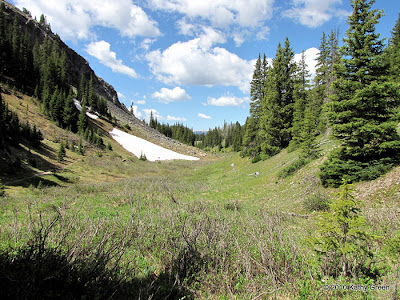The Well Diversified Garden, or Who Needs a Lawn Anyway?
Waterwise gardens thrive above 7000' in Colorado - no lawn here
The article below was originally written by me and published in the October 2009 Edition of Our Community News.
Take a drive around almost any neighborhood in the USA, and you’ll see the same thing. Yards are all green and boring, each having a nicely mown lawn, a few shrubs, some juniper or other pine trees, a nice ornamental tree or two and some petunias or other annuals for color. Then every once in a while your eyes will be drawn to a yard that is different – and it’s easy to see why – it has many types of flowers, herbs, shrubs and trees with a small but functional area given to grass. These two types of yards are different in many ways, with the first relying on us to take care of it, and the second taking care of itself.
Permeable pathways that are criss-crossed with thymes and veronicas keep out weeds and let air, water, and nutrients get to the plants roots
The first type of yard represents a monoculture of plants, while the second has diversity. A monoculture exists when the same type of plant is used extensively in a given space, whether that is a garden, a yard, a neighborhood or a city. It’s kind of like putting all of your money into one stock. When the stock is performing well, life’s good. But when the stock tanks you potentially lose everything. The plant kingdom is the same.
Lodgepole Pine forests turned red with dead trees from pine beetles above Dillon Reservoir, Colorado
A functional and recreational bit of non-irrigated lawn, Turf-Type Tall Fescue under Ponderosa Pines
What makes a diversified garden/yard better than a monoculture? There are many things – sustainability, pest and disease resistance, providing food for many types of insects, birds, wildlife and people, feeding the “soil web”, better use of water resources, and little to no dependence on fertilizer, pesticides and herbicides.
Waterwise gardens are far easier to take care of on a slope than trying to mow grass!
Designing a well diversified garden is easier than you might think, and costs less in the long run than large swaths of green grass. Most importantly, a diversity of plants is much better for you, your neighborhood and the planet. Having many different plants does not just mean throwing a bunch of them together and calling it a garden.
Gardens like these are packed with perennials, groundcovers and herbs, so no room for weeds
Planting for pollinators of all types helps to ensure flowers provide lots of food, even when you don't have full sun.
When designing your garden or yard it’s important to have enough different types of plants to help control pests, provide food, and still be beautiful. For each plant you want to include in your garden, ask yourself 4 things: 1) Does the plant provide food, shelter, or pollen? 2) Does the plant have natural resistance to pests and/or diseases? 3) Does the plant provide more than one season of interest? 4) Can the plant thrive without lots of supplemental water once it is established? If you answered “yes” for at least 3 of these questions, consider the plant for your garden or yard. If not, move on to the next plant. There are literally thousands of plants that will have “yes” answers and will grow in our planting zones, so take the time to seek them out and plant them! Who knows, you might not even miss that sea of green that was once your front lawn.
A small, shady section of my lawn-less front yard
For more information on lawn alternatives, drop by the Lawn Reform.org website and check out what you can do to help change our love affair with the American lawn.


Ok, that does it. I have one patch of grass left in my yard and now it's going next year.
ReplyDeleteThis is a great post, thanks for the tips and info.
Rosey
I enjoyed your article, thank you! A lot of ideas are in these pictures.
ReplyDeleteGreat blog - glad I found you!
ReplyDeleteKathy, what great information you have here! I'm so glad I've found another gardener who makes wildlife a priority. I've added this site to my reader and am looking forward to following more of your writing.
ReplyDeleteReally good article. A good one to get people up and moving about the beautiful lawn issue.
ReplyDeleteI can't imagine anyone who would want to plant a lawn after reading your article. Who would want a lawn when they can lots of texture and color instead?
ReplyDelete